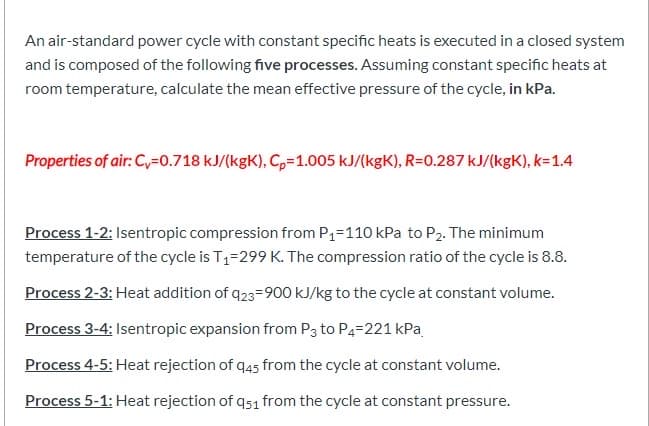An air-standard power cycle with constant specific heats is executed in a closed system and is composed of the following five processes. Assuming constant specific heats at room temperature, calculate the mean effective pressure of the cycle, in kPa. Properties of air: C,=0.718 kJ/(kgK), C,=1.005 kJ/(kgK), R=0.287 kJ/(kgK), k=1.4 Process 1-2: Isentropic compression from Pz=110 kPa to P2. The minimum temperature of the cycle is T1=299 K. The compression ratio of the cycle is 8.8. Process 2-3: Heat addition of q23=900 kJ/kg to the cycle at constant volume. Process 3-4: Isentropic expansion from P3 to P4=221 kPa Process 4-5: Heat rejection of q45 from the cycle at constant volume. Process 5-1: Heat rejection of q51 from the cycle at constant pressure.
An air-standard power cycle with constant specific heats is executed in a closed system and is composed of the following five processes. Assuming constant specific heats at room temperature, calculate the mean effective pressure of the cycle, in kPa. Properties of air: C,=0.718 kJ/(kgK), C,=1.005 kJ/(kgK), R=0.287 kJ/(kgK), k=1.4 Process 1-2: Isentropic compression from Pz=110 kPa to P2. The minimum temperature of the cycle is T1=299 K. The compression ratio of the cycle is 8.8. Process 2-3: Heat addition of q23=900 kJ/kg to the cycle at constant volume. Process 3-4: Isentropic expansion from P3 to P4=221 kPa Process 4-5: Heat rejection of q45 from the cycle at constant volume. Process 5-1: Heat rejection of q51 from the cycle at constant pressure.
Elements Of Electromagnetics
7th Edition
ISBN:9780190698614
Author:Sadiku, Matthew N. O.
Publisher:Sadiku, Matthew N. O.
ChapterMA: Math Assessment
Section: Chapter Questions
Problem 1.1MA
Related questions
Question

Transcribed Image Text:An air-standard power cycle with constant specific heats is executed in a closed system
and is composed of the following five processes. Assuming constant specific heats at
room temperature, calculate the mean effective pressure of the cycle, in kPa.
Properties of air: C,=0.718 kJ/(kgK), C,=1.005 kJ/(kgK), R=0.287 kJ/(kgK), k=1.4
Process 1-2: Isentropic compression from P1=110 kPa to P2. The minimum
temperature of the cycle is T1=299 K. The compression ratio of the cycle is 8.8.
Process 2-3: Heat addition of q23=900 kJ/kg to the cycle at constant volume.
Process 3-4: Isentropic expansion from P3 to P4=221 kPa
Process 4-5: Heat rejection of q45 from the cycle at constant volume.
Process 5-1: Heat rejection of q51 from the cycle at constant pressure.
Expert Solution
This question has been solved!
Explore an expertly crafted, step-by-step solution for a thorough understanding of key concepts.
Step by step
Solved in 5 steps

Knowledge Booster
Learn more about
Need a deep-dive on the concept behind this application? Look no further. Learn more about this topic, mechanical-engineering and related others by exploring similar questions and additional content below.Recommended textbooks for you

Elements Of Electromagnetics
Mechanical Engineering
ISBN:
9780190698614
Author:
Sadiku, Matthew N. O.
Publisher:
Oxford University Press

Mechanics of Materials (10th Edition)
Mechanical Engineering
ISBN:
9780134319650
Author:
Russell C. Hibbeler
Publisher:
PEARSON

Thermodynamics: An Engineering Approach
Mechanical Engineering
ISBN:
9781259822674
Author:
Yunus A. Cengel Dr., Michael A. Boles
Publisher:
McGraw-Hill Education

Elements Of Electromagnetics
Mechanical Engineering
ISBN:
9780190698614
Author:
Sadiku, Matthew N. O.
Publisher:
Oxford University Press

Mechanics of Materials (10th Edition)
Mechanical Engineering
ISBN:
9780134319650
Author:
Russell C. Hibbeler
Publisher:
PEARSON

Thermodynamics: An Engineering Approach
Mechanical Engineering
ISBN:
9781259822674
Author:
Yunus A. Cengel Dr., Michael A. Boles
Publisher:
McGraw-Hill Education

Control Systems Engineering
Mechanical Engineering
ISBN:
9781118170519
Author:
Norman S. Nise
Publisher:
WILEY

Mechanics of Materials (MindTap Course List)
Mechanical Engineering
ISBN:
9781337093347
Author:
Barry J. Goodno, James M. Gere
Publisher:
Cengage Learning

Engineering Mechanics: Statics
Mechanical Engineering
ISBN:
9781118807330
Author:
James L. Meriam, L. G. Kraige, J. N. Bolton
Publisher:
WILEY